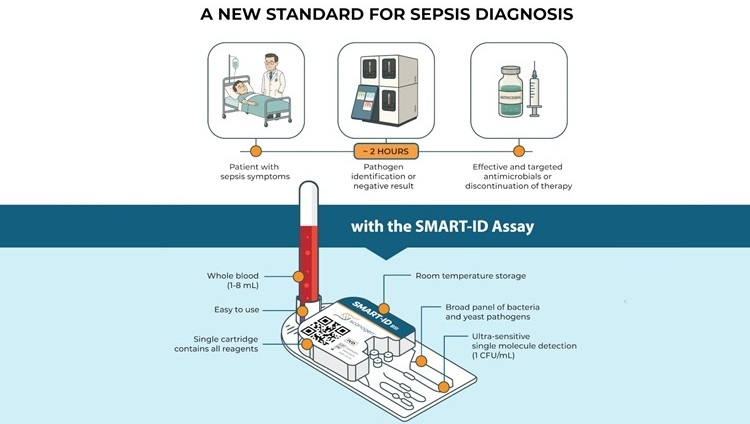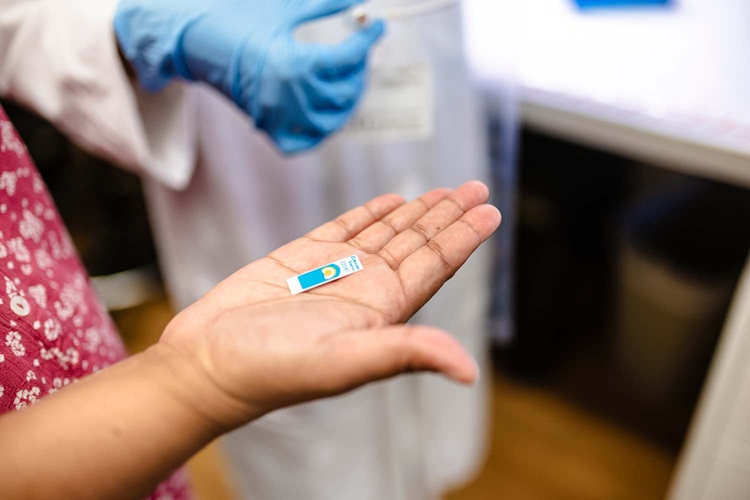First Comprehensive Gene Map of the Human Brain Developed
|
By LabMedica International staff writers Posted on 26 Apr 2011 |
A new human brain atlas reveals more than 90% similarity among humans, and details genes at work throughout the brain to further scientific research and medical outcomes.
The Allen Institute for Brain Science (Seattle, WA, USA) has released the world's first anatomically and genomically comprehensive human brain map, a previously improbable endeavor made possible through leading-edge technology and more than four years of demanding studies and documentation. The mappings are the foundation for the Allen Human Brain Atlas, an online public resource developed to advance the Institute's goal to accelerate understanding of how the human brain works and fuel new discovery among the global research community.
In developing the Allen Human Brain Atlas, the Allen Institute has now characterized and mapped the biochemistry of two normal adult human brains, providing opportunities for scientists to study the brain with new detail and accuracy. The data reveal a remarkable 94% similarity between human brains, establishing strong patterns as a critical foundation for translational and clinical research. Moreover, data analysis from the two human brains indicate that at least 82% of all human genes are expressed in the brain, highlighting its great complexity while also providing an essential genetic blueprint to understand brain functionality better and fuel research in neurologic disease and other brain disorders.
"Until now, a definitive map of the human brain, at this level of detail, simply hasn't existed,” said Allan Jones, PhD, chief executive officer of the Allen Institute for Brain Science. "The Allen Human Brain Atlas provides never-before-seen views into our most complex and most important organ. Understanding how our genes are used in our brains will help scientists and the medical community better understand and discover new treatments for the full spectrum of brain diseases and disorders, from mental illness and drug addiction, to Alzheimer's and Parkinson's diseases, multiple sclerosis, autism, and more.”
Similar to a high-powered, multifunctional GPS (global positioning system) navigation system, the Allen Human Brain Atlas identifies 1,000 anatomic sites in the human brain, underscored by more than 100 million data points that indicate the particular gene expression and underlying biochemistry of each site. Scientists can utilize the Allen Human Brain Atlas to explore the human brain and identify how disease and trauma, including physical brain injuries and mental health disorders, affect specific areas of the brain. This resource makes it possible to pinpoint where a particular drug acts anatomically in the brain, to ultimately better control the successful outcome of numerous therapies.
"The Allen Institute is a powerful force in modern science,” said Dr. Edward Jones, neuroscientist at the University of California, Davis. "They've applied an industrialized approach and high-output technology to accomplish what no other lab has ever done. The original data produced for the mouse brain revolutionized neuroscience and now the Allen Human Brain Atlas delivers extremely rare and essential information that most researchers could not otherwise access. They are truly paving the way for the future of research."
The Allen Human Brain Atlas is free and available to scientists, physicians, and the education community as an online public resource (please see Related Links below).
Previously, as its inaugural initiative, the Allen Institute for Brain Science completed mappings of the adult mouse brain in 2006, similarly making the data available free to scientists. Overall, those data have led to a number of significant research advances worldwide, including the publishing of over 500 peer-reviewed papers citing the Allen Mouse Brain Atlas to support research conclusions.
A significant feature of the Atlas that makes it a powerful research tool is that it fully integrates several different kinds of data across different scales of brain exploration. Data incorporated into the Atlas include magnetic resonance imaging (MRI), diffusion tensor imaging (DTI), as well as histology and gene expression data derived from both microarray and in-situ hybridization (ISH) approaches.
Users of the Allen Human Brain Atlas comprise a diverse range of biomedical researchers--primarily neuroscientists--throughout the world. They include scientists who study the human brain itself, as well as those working in mouse and other model systems, providing a rare and important opportunity for them to probe the relevance of the findings to humans. Some 4,000 unique visitors are now accessing the new Atlas each month.
It is anticipated that the Allen Human Brain Atlas will be used in small and large-scale applications to examine diseases and disorders, such as obesity, Parkinson's disease, autism, schizophrenia, Alzheimer's disease, and multiple sclerosis--as well as those exploring how the healthy brain works.
The Allen Institute for Brain Science will continue to expand the Allen Human Brain Atlas in the coming years, with new data from additional brains, as well as enhanced tools for searching, analyzing, and viewing the data.
The Allen Institute for Brain Science is a medical research organization focused on accelerating understanding of the human brain by driving discovery for the broader scientific community.
Related Links:
Allen Institute for Brain Science
Allen Human Brain Atlas
The Allen Institute for Brain Science (Seattle, WA, USA) has released the world's first anatomically and genomically comprehensive human brain map, a previously improbable endeavor made possible through leading-edge technology and more than four years of demanding studies and documentation. The mappings are the foundation for the Allen Human Brain Atlas, an online public resource developed to advance the Institute's goal to accelerate understanding of how the human brain works and fuel new discovery among the global research community.
In developing the Allen Human Brain Atlas, the Allen Institute has now characterized and mapped the biochemistry of two normal adult human brains, providing opportunities for scientists to study the brain with new detail and accuracy. The data reveal a remarkable 94% similarity between human brains, establishing strong patterns as a critical foundation for translational and clinical research. Moreover, data analysis from the two human brains indicate that at least 82% of all human genes are expressed in the brain, highlighting its great complexity while also providing an essential genetic blueprint to understand brain functionality better and fuel research in neurologic disease and other brain disorders.
"Until now, a definitive map of the human brain, at this level of detail, simply hasn't existed,” said Allan Jones, PhD, chief executive officer of the Allen Institute for Brain Science. "The Allen Human Brain Atlas provides never-before-seen views into our most complex and most important organ. Understanding how our genes are used in our brains will help scientists and the medical community better understand and discover new treatments for the full spectrum of brain diseases and disorders, from mental illness and drug addiction, to Alzheimer's and Parkinson's diseases, multiple sclerosis, autism, and more.”
Similar to a high-powered, multifunctional GPS (global positioning system) navigation system, the Allen Human Brain Atlas identifies 1,000 anatomic sites in the human brain, underscored by more than 100 million data points that indicate the particular gene expression and underlying biochemistry of each site. Scientists can utilize the Allen Human Brain Atlas to explore the human brain and identify how disease and trauma, including physical brain injuries and mental health disorders, affect specific areas of the brain. This resource makes it possible to pinpoint where a particular drug acts anatomically in the brain, to ultimately better control the successful outcome of numerous therapies.
"The Allen Institute is a powerful force in modern science,” said Dr. Edward Jones, neuroscientist at the University of California, Davis. "They've applied an industrialized approach and high-output technology to accomplish what no other lab has ever done. The original data produced for the mouse brain revolutionized neuroscience and now the Allen Human Brain Atlas delivers extremely rare and essential information that most researchers could not otherwise access. They are truly paving the way for the future of research."
The Allen Human Brain Atlas is free and available to scientists, physicians, and the education community as an online public resource (please see Related Links below).
Previously, as its inaugural initiative, the Allen Institute for Brain Science completed mappings of the adult mouse brain in 2006, similarly making the data available free to scientists. Overall, those data have led to a number of significant research advances worldwide, including the publishing of over 500 peer-reviewed papers citing the Allen Mouse Brain Atlas to support research conclusions.
A significant feature of the Atlas that makes it a powerful research tool is that it fully integrates several different kinds of data across different scales of brain exploration. Data incorporated into the Atlas include magnetic resonance imaging (MRI), diffusion tensor imaging (DTI), as well as histology and gene expression data derived from both microarray and in-situ hybridization (ISH) approaches.
Users of the Allen Human Brain Atlas comprise a diverse range of biomedical researchers--primarily neuroscientists--throughout the world. They include scientists who study the human brain itself, as well as those working in mouse and other model systems, providing a rare and important opportunity for them to probe the relevance of the findings to humans. Some 4,000 unique visitors are now accessing the new Atlas each month.
It is anticipated that the Allen Human Brain Atlas will be used in small and large-scale applications to examine diseases and disorders, such as obesity, Parkinson's disease, autism, schizophrenia, Alzheimer's disease, and multiple sclerosis--as well as those exploring how the healthy brain works.
The Allen Institute for Brain Science will continue to expand the Allen Human Brain Atlas in the coming years, with new data from additional brains, as well as enhanced tools for searching, analyzing, and viewing the data.
The Allen Institute for Brain Science is a medical research organization focused on accelerating understanding of the human brain by driving discovery for the broader scientific community.
Related Links:
Allen Institute for Brain Science
Allen Human Brain Atlas
Latest BioResearch News
- Genome Analysis Predicts Likelihood of Neurodisability in Oxygen-Deprived Newborns
- Gene Panel Predicts Disease Progession for Patients with B-cell Lymphoma
- New Method Simplifies Preparation of Tumor Genomic DNA Libraries
- New Tool Developed for Diagnosis of Chronic HBV Infection
- Panel of Genetic Loci Accurately Predicts Risk of Developing Gout
- Disrupted TGFB Signaling Linked to Increased Cancer-Related Bacteria
- Gene Fusion Protein Proposed as Prostate Cancer Biomarker
- NIV Test to Diagnose and Monitor Vascular Complications in Diabetes
- Semen Exosome MicroRNA Proves Biomarker for Prostate Cancer
- Genetic Loci Link Plasma Lipid Levels to CVD Risk
- Newly Identified Gene Network Aids in Early Diagnosis of Autism Spectrum Disorder
- Link Confirmed between Living in Poverty and Developing Diseases
- Genomic Study Identifies Kidney Disease Loci in Type I Diabetes Patients
- Liquid Biopsy More Effective for Analyzing Tumor Drug Resistance Mutations
- New Liquid Biopsy Assay Reveals Host-Pathogen Interactions
- Method Developed for Enriching Trophoblast Population in Samples
Channels
Clinical Chemistry
view channel
POC Breath Diagnostic System to Detect Pneumonia-Causing Pathogens
Pseudomonas aeruginosa is a major cause of hospital-acquired and ventilator-associated pneumonia, particularly in lung transplant recipients and patients with structural lung disease. Its ability to form... Read more
Online Tool Detects Drug Exposure Directly from Patient Samples
Doctors often rely on patient interviews and medical records to determine what medications a person has taken, but this information is frequently incomplete. People may forget drugs they used, take over-the-counter... Read moreMolecular Diagnostics
view channel
Blood Biomarker Improves Early Brain Injury Prognosis After Cardiac Arrest
After a cardiac arrest, many patients remain unconscious for days, leaving doctors and families facing uncertainty about whether meaningful recovery is possible. Current tools to assess brain damage, including... Read more
Biomarkers Could Identify Patients at High Risk of Severe AKI After Major Surgery
Acute kidney injury is one of the most common and dangerous complications after major surgery, particularly among patients in intensive care. Even mild impairment of kidney function can lead to long-term... Read more
CLIA Test Identifies Head and Neck Cancer Recurrence from Post-Surgical Lymphatic Fluid
While the lymphatic system’s critical role in metastasis has long been recognized, routine access to patient lymph has been elusive. Now, a non-invasive process can access lymph through the collection... Read moreHematology
view channel
MRD Tests Could Predict Survival in Leukemia Patients
Acute myeloid leukemia is an aggressive blood cancer that disrupts normal blood cell production and often relapses even after intensive treatment. Clinicians currently lack early, reliable markers to predict... Read more
Platelet Activity Blood Test in Middle Age Could Identify Early Alzheimer’s Risk
Early detection of Alzheimer’s disease remains one of the biggest unmet needs in neurology, particularly because the biological changes underlying the disorder begin decades before memory symptoms appear.... Read more
Microvesicles Measurement Could Detect Vascular Injury in Sickle Cell Disease Patients
Assessing disease severity in sickle cell disease (SCD) remains challenging, especially when trying to predict hemolysis, vascular injury, and risk of complications such as vaso-occlusive crises.... Read more
ADLM’s New Coagulation Testing Guidance to Improve Care for Patients on Blood Thinners
Direct oral anticoagulants (DOACs) are one of the most common types of blood thinners. Patients take them to prevent a host of complications that could arise from blood clotting, including stroke, deep... Read moreImmunology
view channelBlood Test Could Detect Adverse Immunotherapy Effects
Immune checkpoint inhibitors have transformed cancer treatment, but they can also trigger serious immune-related adverse events that damage healthy organs and may become life-threatening if not detected early.... Read more
Routine Blood Test Can Predict Who Benefits Most from CAR T-Cell Therapy
CAR T-cell therapy has transformed treatment for patients with relapsed or treatment-resistant non-Hodgkin lymphoma, but many patients eventually relapse despite an initial response. Clinicians currently... Read moreMicrobiology
view channel
Blood-Based Diagnostic Method Could Identify Pediatric LRTIs
Lower-respiratory tract infections (LRTIs) are a leading cause of illness and death worldwide, and pneumonia is the leading infectious cause of death in children under five, claiming the lives of over... Read more
Rapid Diagnostic Test Matches Gold Standard for Sepsis Detection
Sepsis kills 11 million people worldwide every year and generates massive healthcare costs. In the USA and Europe alone, sepsis accounts for USD 100 billion in annual hospitalization expenses.... Read moreRapid POC Tuberculosis Test Provides Results Within 15 Minutes
Tuberculosis remains one of the world’s deadliest infectious diseases, and reducing new cases depends on identifying individuals with latent infection before it progresses. Current diagnostic tools often... Read more
Rapid Assay Identifies Bloodstream Infection Pathogens Directly from Patient Samples
Bloodstream infections in sepsis progress quickly and demand rapid, precise diagnosis. Current blood-culture methods often take one to five days to identify the pathogen, leaving clinicians to treat blindly... Read morePathology
view channel
Rapid Low-Cost Tests Can Prevent Child Deaths from Contaminated Medicinal Syrups
Medicinal syrups contaminated with toxic chemicals have caused the deaths of hundreds of children worldwide, exposing a critical gap in how these products are tested before reaching patients.... Read more
Tumor Signals in Saliva and Blood Enable Non-Invasive Monitoring of Head and Neck Cancer
Head and neck cancers are among the most aggressive malignancies worldwide, with nearly 900,000 new cases diagnosed each year. Monitoring these cancers for recurrence or relapse typically relies on tissue... Read more
Common Health Issues Can Influence New Blood Tests for Alzheimer’s Disease
Blood-based tests for Alzheimer’s disease are transforming diagnosis by offering a simpler alternative to spinal taps and brain imaging. However, many people evaluated at memory clinics also live with... Read more
Blood Test Formula Identifies Chronic Liver Disease Patients with Higher Cancer Risk
Chronic liver disease affects millions worldwide and can progress silently to hepatocellular carcinoma (HCC), one of the deadliest cancers globally. While surveillance guidelines exist for patients with... Read moreTechnology
view channel
Machine Learning Models Diagnose ALS Earlier Through Blood Biomarkers
Amyotrophic lateral sclerosis (ALS) is a rapidly progressive neurodegenerative disease that is notoriously difficult to diagnose in its early stages. Early symptoms often overlap with other neurological... Read more
Artificial Intelligence Model Could Accelerate Rare Disease Diagnosis
Identifying which genetic variants actually cause disease remains one of the biggest challenges in genomic medicine. Each person carries tens of thousands of DNA changes, yet only a few meaningfully alter... Read moreIndustry
view channel
BD and Penn Institute Collaborate to Advance Immunotherapy through Flow Cytometry
BD (Becton, Dickinson and Company, Franklin Lakes, NJ, USA) has entered into a strategic collaboration with the Institute for Immunology and Immune Health (I3H, Philadelphia, PA, USA) at the University... Read more




















